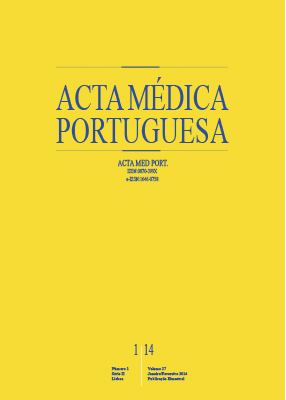Aerobic Program in Persons with Stroke: A Systematic Review
DOI:
https://doi.org/10.20344/amp.4900Abstract
Introduction: The aim of this study was to perform a systematic review on the exercise trials post stroke.
Material and Methods: Therefore, we conducted a systematic review of randomized controlled clinical trials published in PubMed and PEDro. The inclusion criteria were: Studies – randomized or controlled clinical trials; Participants – Adults of any age with a clinical diagnosis of stroke; Interventions – any aerobic physical training aimed at improving cardiovascular capacity and/or function. Two independent reviewers categorized the selected trials, assessed methodological quality and extracted the relevant data. Various protocols were analyzed and used for both the assessment and physical training of post-stroke subjects.
Results: According to clinical trials analyze, a wide range of instruments were used to measure functional capacity. Ergospirometry and ergometry were found to be main devices in the assessment of cardiovascular capacity. Cycle ergometer training was the most commonly used training strategy, and conventional physiotherapy (based on stretching, strengthening, balance, coordination and gait training) was the most frequent control therapy.
Discussion: Training duration ranged from 4 weeks to 6 months; the mean weekly frequency was 3 sessions per week while training intensity ranged from 40 to 80% of maximal heart rate or VO2 peak. Duration of training sessions ranged from 25 minutes to 1 hour.
Conclusion: Exercise training is a promising tool for the management of post-stroke patients, both in terms of improved cardiovascular and functional capacity. Further studies are needed to widen the scope of therapeutic management of this population.
Downloads
Downloads
Published
How to Cite
Issue
Section
License
All the articles published in the AMP are open access and comply with the requirements of funding agencies or academic institutions. The AMP is governed by the terms of the Creative Commons ‘Attribution – Non-Commercial Use - (CC-BY-NC)’ license, regarding the use by third parties.
It is the author’s responsibility to obtain approval for the reproduction of figures, tables, etc. from other publications.
Upon acceptance of an article for publication, the authors will be asked to complete the ICMJE “Copyright Liability and Copyright Sharing Statement “(http://www.actamedicaportuguesa.com/info/AMP-NormasPublicacao.pdf) and the “Declaration of Potential Conflicts of Interest” (http:// www.icmje.org/conflicts-of-interest). An e-mail will be sent to the corresponding author to acknowledge receipt of the manuscript.
After publication, the authors are authorised to make their articles available in repositories of their institutions of origin, as long as they always mention where they were published and according to the Creative Commons license.









